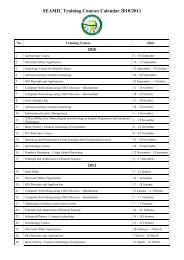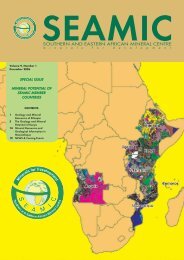SEAMIC Newsletter Vol. 10
SEAMIC Newsletter Vol. 10
SEAMIC Newsletter Vol. 10
Create successful ePaper yourself
Turn your PDF publications into a flip-book with our unique Google optimized e-Paper software.
Despite having such a geological environment, which is conducive for hosting diverse types of<br />
mineralization, most of the mining activities in Tanzania (gold and diamonds) are concentrated<br />
in the Archean Craton. However, in recent years, mining activities of these minerals have been<br />
extended to the mobile belts, a situation facilitated by the fact that most of the lithologies in<br />
the mobile belts originate from tectonic reworking of the marginal portions of the Craton as<br />
proved by most of the recent geochronological research findings available at the Geological<br />
Survey of Tanzania.<br />
ATTRACTIVE INVESTMENT ENVIRONMENT<br />
In the past few years, Tanzania reviewed its investment policy and adopted a Fiscal and<br />
Regulatory regime that has succeeded to attract large private sector led capital investments in a<br />
number of production sectors, mining inclusive. These policy reforms coupled with the good<br />
geological environment have led to the opening up of modern mines including six world class<br />
gold mines of North Mara (Africa Mashariki), Buhemba, Geita, Tulawaka, Bulyanhulu<br />
(Kahama), and Nzega (Golden Pride); one tanzanite mine at Merelani and one diamond mine<br />
at Mwadui. Buzwagi gold mine and Kabanga nickel mine are in an advanced stage of mine<br />
development.<br />
MINERAL DEPOSITS<br />
Gold<br />
About 90% of the total gold output has been won from the Archean Tanzania craton greenstone<br />
belts south and east of Lake Victoria in Northern Tanzania. The remainder of the gold output<br />
has been from the Ubendian Proterozoic rocks, principally in the Lupa in the southwest and<br />
Mpanda fields in the west-central Tanzania. Archean greenstones were deposited in weak zones<br />
in the primitive crust and subsequently affected by intense folding and intrusion of granites.<br />
New exploration fronts include the Kitowero Proterozoic rocks in Masasi south eastern<br />
Tanzania, Mbinga in the southwest, Handeni, Kilosa, Morogoro and Muheza in the east. The<br />
exploration trend now focuses on the mobile belts which have proved in part to represent<br />
tectonically reworked Archean crust. Gold is also known in epithermal Prospects like<br />
Wingayongo in the south east. Rich deposits in the matrix of cobbles in zones over bedrock are<br />
being mined in possibly Tertiary to Quaternary laterites and lateritic soils in the Rwamagaza<br />
greenstone belt at Buziba.<br />
Geita greenstone belt: This is an east-west trending belt which hosts the world class Geita<br />
Gold mine with a resource of 20 million ounces grading on average 4.0 g/t. The greenstone belt<br />
is marked by high relief hills, ridges and a plateau underlain by steeply dipping banded iron<br />
formation (BIF). The Nyanzian Supergroup formations comprise pyroclastics, overlying mafic<br />
volcanics. Laterite is well developed at the surface over mafic volcanic units. Gold<br />
mineralization occurs in native form, often in close association with pyrite, and pyrrhotite in<br />
fractures concordant with the bedding of banded iron formation units. Stratiform<br />
mineralization predominates although quartz reefs are mineralized at some deposits.<br />
Other Gold deposits in the belt include: Lone Cone with a resource of 3.5 M oz; Nyamulilima<br />
has a resource of 2 M oz; The Ridge 8 has a resource of over 0.5 M oz; The Saragura or Allways<br />
Deposit has a gold resource of over 271,000 ounces of gold.<br />
Rwamagaza greenstone belt: This belt lies south of the Geita Greenstone belt and probably<br />
represents the same rocks on the other limb of an anticlinorium. Outcrops of massive mafic<br />
volcanics with some thin beds of tuff are notable. The principal gold mine used to be Mawe<br />
Meru, which is a high grade gold quartz vein containing much pyrite and chalcopyrite. The<br />
9




